Jianglong Ye
Co-Design of Soft Gripper with Neural Physics
May 26, 2025Abstract:For robot manipulation, both the controller and end-effector design are crucial. Soft grippers are generalizable by deforming to different geometries, but designing such a gripper and finding its grasp pose remains challenging. In this paper, we propose a co-design framework that generates an optimized soft gripper's block-wise stiffness distribution and its grasping pose, using a neural physics model trained in simulation. We derived a uniform-pressure tendon model for a flexure-based soft finger, then generated a diverse dataset by randomizing both gripper pose and design parameters. A neural network is trained to approximate this forward simulation, yielding a fast, differentiable surrogate. We embed that surrogate in an end-to-end optimization loop to optimize the ideal stiffness configuration and best grasp pose. Finally, we 3D-print the optimized grippers of various stiffness by changing the structural parameters. We demonstrate that our co-designed grippers significantly outperform baseline designs in both simulation and hardware experiments.
M3: 3D-Spatial MultiModal Memory
Mar 20, 2025Abstract:We present 3D Spatial MultiModal Memory (M3), a multimodal memory system designed to retain information about medium-sized static scenes through video sources for visual perception. By integrating 3D Gaussian Splatting techniques with foundation models, M3 builds a multimodal memory capable of rendering feature representations across granularities, encompassing a wide range of knowledge. In our exploration, we identify two key challenges in previous works on feature splatting: (1) computational constraints in storing high-dimensional features for each Gaussian primitive, and (2) misalignment or information loss between distilled features and foundation model features. To address these challenges, we propose M3 with key components of principal scene components and Gaussian memory attention, enabling efficient training and inference. To validate M3, we conduct comprehensive quantitative evaluations of feature similarity and downstream tasks, as well as qualitative visualizations to highlight the pixel trace of Gaussian memory attention. Our approach encompasses a diverse range of foundation models, including vision-language models (VLMs), perception models, and large multimodal and language models (LMMs/LLMs). Furthermore, to demonstrate real-world applicability, we deploy M3's feature field in indoor scenes on a quadruped robot. Notably, we claim that M3 is the first work to address the core compression challenges in 3D feature distillation.
Learning Generalizable Feature Fields for Mobile Manipulation
Mar 12, 2024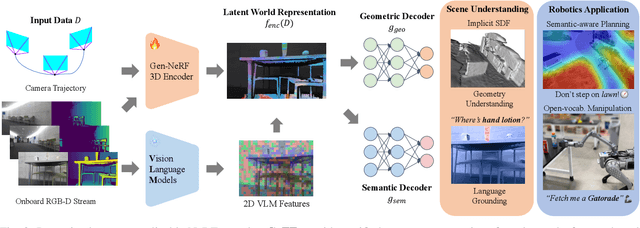

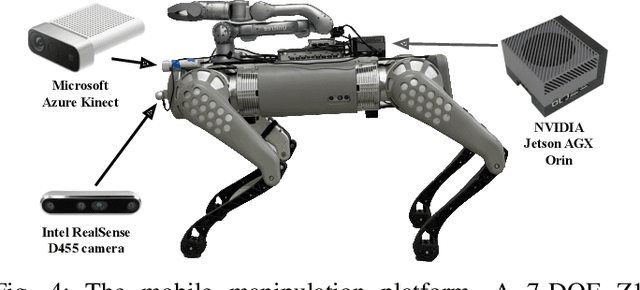
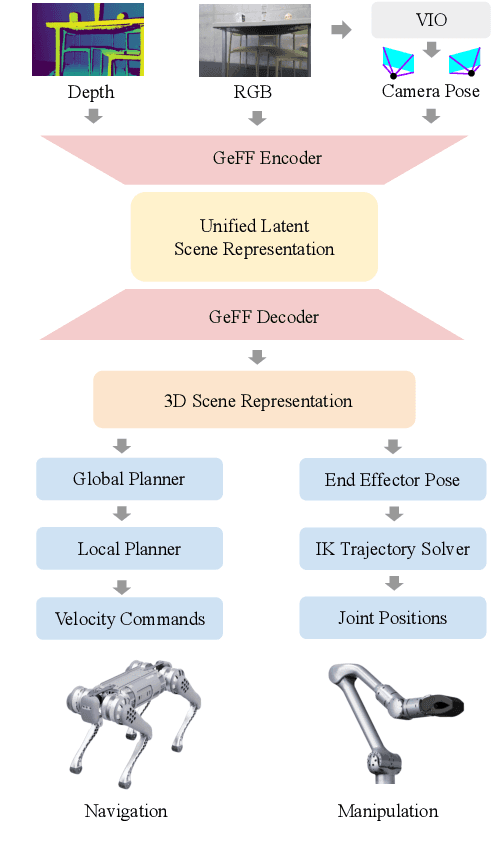
Abstract:An open problem in mobile manipulation is how to represent objects and scenes in a unified manner, so that robots can use it both for navigating in the environment and manipulating objects. The latter requires capturing intricate geometry while understanding fine-grained semantics, whereas the former involves capturing the complexity inherit to an expansive physical scale. In this work, we present GeFF (Generalizable Feature Fields), a scene-level generalizable neural feature field that acts as a unified representation for both navigation and manipulation that performs in real-time. To do so, we treat generative novel view synthesis as a pre-training task, and then align the resulting rich scene priors with natural language via CLIP feature distillation. We demonstrate the effectiveness of this approach by deploying GeFF on a quadrupedal robot equipped with a manipulator. We evaluate GeFF's ability to generalize to open-set objects as well as running time, when performing open-vocabulary mobile manipulation in dynamic scenes.
Consistent-1-to-3: Consistent Image to 3D View Synthesis via Geometry-aware Diffusion Models
Oct 04, 2023



Abstract:Zero-shot novel view synthesis (NVS) from a single image is an essential problem in 3D object understanding. While recent approaches that leverage pre-trained generative models can synthesize high-quality novel views from in-the-wild inputs, they still struggle to maintain 3D consistency across different views. In this paper, we present Consistent-1-to-3, which is a generative framework that significantly mitigate this issue. Specifically, we decompose the NVS task into two stages: (i) transforming observed regions to a novel view, and (ii) hallucinating unseen regions. We design a scene representation transformer and view-conditioned diffusion model for performing these two stages respectively. Inside the models, to enforce 3D consistency, we propose to employ epipolor-guided attention to incorporate geometry constraints, and multi-view attention to better aggregate multi-view information. Finally, we design a hierarchy generation paradigm to generate long sequences of consistent views, allowing a full 360 observation of the provided object image. Qualitative and quantitative evaluation over multiple datasets demonstrate the effectiveness of the proposed mechanisms against state-of-the-art approaches. Our project page is at https://jianglongye.com/consistent123/
GNFactor: Multi-Task Real Robot Learning with Generalizable Neural Feature Fields
Sep 01, 2023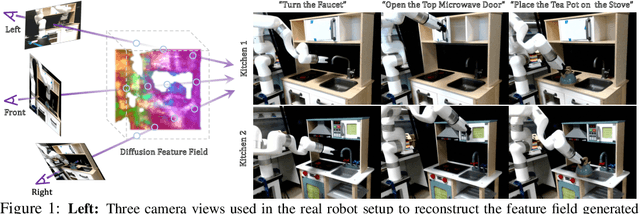

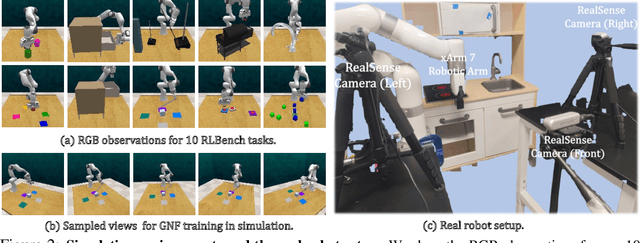

Abstract:It is a long-standing problem in robotics to develop agents capable of executing diverse manipulation tasks from visual observations in unstructured real-world environments. To achieve this goal, the robot needs to have a comprehensive understanding of the 3D structure and semantics of the scene. In this work, we present $\textbf{GNFactor}$, a visual behavior cloning agent for multi-task robotic manipulation with $\textbf{G}$eneralizable $\textbf{N}$eural feature $\textbf{F}$ields. GNFactor jointly optimizes a generalizable neural field (GNF) as a reconstruction module and a Perceiver Transformer as a decision-making module, leveraging a shared deep 3D voxel representation. To incorporate semantics in 3D, the reconstruction module utilizes a vision-language foundation model ($\textit{e.g.}$, Stable Diffusion) to distill rich semantic information into the deep 3D voxel. We evaluate GNFactor on 3 real robot tasks and perform detailed ablations on 10 RLBench tasks with a limited number of demonstrations. We observe a substantial improvement of GNFactor over current state-of-the-art methods in seen and unseen tasks, demonstrating the strong generalization ability of GNFactor. Our project website is https://yanjieze.com/GNFactor/ .
MVDream: Multi-view Diffusion for 3D Generation
Aug 31, 2023



Abstract:We propose MVDream, a multi-view diffusion model that is able to generate geometrically consistent multi-view images from a given text prompt. By leveraging image diffusion models pre-trained on large-scale web datasets and a multi-view dataset rendered from 3D assets, the resulting multi-view diffusion model can achieve both the generalizability of 2D diffusion and the consistency of 3D data. Such a model can thus be applied as a multi-view prior for 3D generation via Score Distillation Sampling, where it greatly improves the stability of existing 2D-lifting methods by solving the 3D consistency problem. Finally, we show that the multi-view diffusion model can also be fine-tuned under a few shot setting for personalized 3D generation, i.e. DreamBooth3D application, where the consistency can be maintained after learning the subject identity.
FeatureNeRF: Learning Generalizable NeRFs by Distilling Foundation Models
Mar 22, 2023



Abstract:Recent works on generalizable NeRFs have shown promising results on novel view synthesis from single or few images. However, such models have rarely been applied on other downstream tasks beyond synthesis such as semantic understanding and parsing. In this paper, we propose a novel framework named FeatureNeRF to learn generalizable NeRFs by distilling pre-trained vision foundation models (e.g., DINO, Latent Diffusion). FeatureNeRF leverages 2D pre-trained foundation models to 3D space via neural rendering, and then extract deep features for 3D query points from NeRF MLPs. Consequently, it allows to map 2D images to continuous 3D semantic feature volumes, which can be used for various downstream tasks. We evaluate FeatureNeRF on tasks of 2D/3D semantic keypoint transfer and 2D/3D object part segmentation. Our extensive experiments demonstrate the effectiveness of FeatureNeRF as a generalizable 3D semantic feature extractor. Our project page is available at https://jianglongye.com/featurenerf/ .
Learning Continuous Grasping Function with a Dexterous Hand from Human Demonstrations
Jul 12, 2022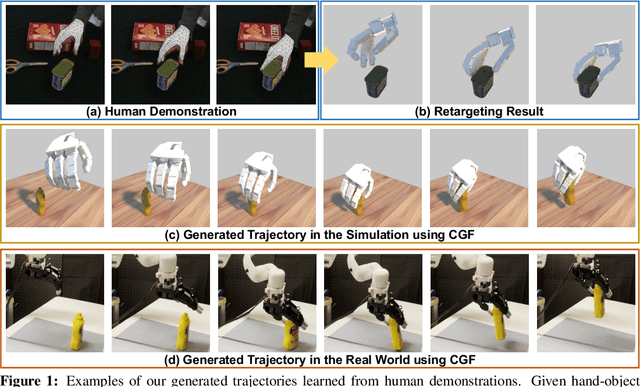

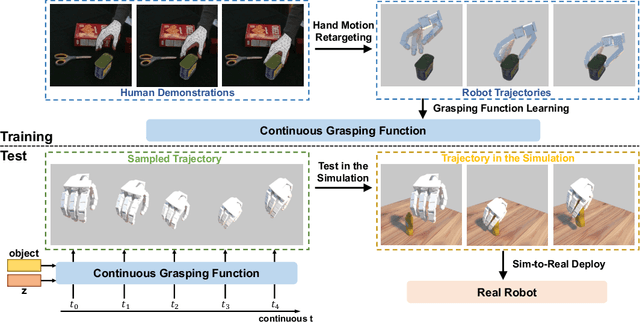

Abstract:We propose to learn to generate grasping motion for manipulation with a dexterous hand using implicit functions. With continuous time inputs, the model can generate a continuous and smooth grasping plan. We name the proposed model Continuous Grasping Function (CGF). CGF is learned via generative modeling with a Conditional Variational Autoencoder using 3D human demonstrations. We will first convert the large-scale human-object interaction trajectories to robot demonstrations via motion retargeting, and then use these demonstrations to train CGF. During inference, we perform sampling with CGF to generate different grasping plans in the simulator and select the successful ones to transfer to the real robot. By training on diverse human data, our CGF allows generalization to manipulate multiple objects. Compared to previous planning algorithms, CGF is more efficient and achieves significant improvement on success rate when transferred to grasping with the real Allegro Hand. Our project page is at https://jianglongye.com/cgf .
GIFS: Neural Implicit Function for General Shape Representation
Apr 14, 2022



Abstract:Recent development of neural implicit function has shown tremendous success on high-quality 3D shape reconstruction. However, most works divide the space into inside and outside of the shape, which limits their representing power to single-layer and watertight shapes. This limitation leads to tedious data processing (converting non-watertight raw data to watertight) as well as the incapability of representing general object shapes in the real world. In this work, we propose a novel method to represent general shapes including non-watertight shapes and shapes with multi-layer surfaces. We introduce General Implicit Function for 3D Shape (GIFS), which models the relationships between every two points instead of the relationships between points and surfaces. Instead of dividing 3D space into predefined inside-outside regions, GIFS encodes whether two points are separated by any surface. Experiments on ShapeNet show that GIFS outperforms previous state-of-the-art methods in terms of reconstruction quality, rendering efficiency, and visual fidelity. Project page is available at https://jianglongye.com/gifs .
Online Adaptation for Implicit Object Tracking and Shape Reconstruction in the Wild
Nov 24, 2021



Abstract:Tracking and reconstructing 3D objects from cluttered scenes are the key components for computer vision, robotics and autonomous driving systems. While recent progress in implicit function (e.g., DeepSDF) has shown encouraging results on high-quality 3D shape reconstruction, it is still very challenging to generalize to cluttered and partially observable LiDAR data. In this paper, we propose to leverage the continuity in video data. We introduce a novel and unified framework which utilizes a DeepSDF model to simultaneously track and reconstruct 3D objects in the wild. We online adapt the DeepSDF model in the video, iteratively improving the shape reconstruction while in return improving the tracking, and vice versa. We experiment with both Waymo and KITTI datasets, and show significant improvements over state-of-the-art methods for both tracking and shape reconstruction.
 Add to Chrome
Add to Chrome Add to Firefox
Add to Firefox Add to Edge
Add to Edge